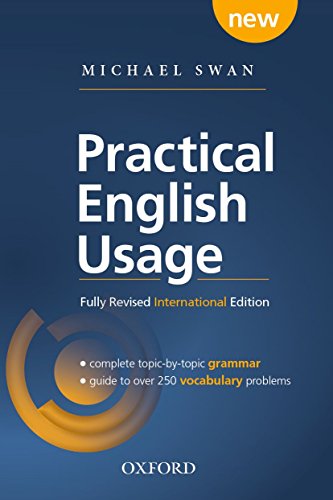Description
Practical English Usage INTERNATIONAL 4th Edition (without online access) by Michael Swan, ISBN-13: 978-0194202466
[PDF eBook eTextbook] – Available Instantly
376 pages
Publisher: Cambridge University Press; 1 edition (November 26, 2001)
Language: English
ISBN-10: 0521792851
ISBN-13: 978-0521792851
Your indispensable guide to problems in English.
Practical English Usage is recommended for any teacher, trainee teacher, or advanced-level student looking for answers to questions about the English language. The material is now organised in two parts (grammar and vocabulary), making it easier than ever to find the answers, either online or in print.
Part 1 is a complete practical learner’s grammar with 28 sections, covering all the structural points that cause problems for learners.
Part 2 is a guide to vocabulary problems covering:
– rules for word formation and spelling
– a survey of high-priority vocabulary areas
– an A-Z guide to over 250 common word problems
The 600+ entries provide answers to the questions that learners typically ask, for example:
– use of tenses
– the truth about conditionals
– article problems
– singular they
– get as a passive auxiliary
– bring or take?
– can, could, may or might?
– classic or classical?
– the language of emails
– rules for word formation and spelling
Plus:
– the grammar of speech and formal writing
– British-American differences
– questions of style and idiom
– changes in English
– politeness
– avoiding offensive language
– a survey of high-priority vocabulary areas
– a guide to over 250 common vocabulary problems
– lists of learners’ most common mistakes
Contents overview:
This overview gives a general picture of the topics covered in the book; it is not a complete guide to the contents. References are to entry numbers. To find information about a particular point, consult the Index at the back of the book.
Grammar
1
Verbs
INTRODUCTION
1 irregular verbs 2 active verb tenses 3 progressive structures
4 non-progressive verbs 5 progressive with always, etc
6 perfect structures 7 subjects, objects and complements
8 verbs with two objects 9 verbs with both active and passive meanings
10
verb + object + complement: You make me nervous.
11
linking verbs: be, seem, look, etc 12 two-part verbs: phrasal verbs
13 two-part verbs: prepositional verbs 14 verbs of movement: she ran in, etc
15 verb + verb: auxiliary verbs 16 verb + verb: other structures
2
Be, have and do
INTRODUCTION
17 be: general 18 be: progressive forms 19 be with auxiliary do 20 there is
21 have: introduction 22 have: auxiliary verb 23 have: actions
24 have (got): possession, relationships and other states 25 be and have
26 do: introduction 27 do: auxiliary verb 28 do: substitute verb (I may do.)
29
do so/it/that
3
Present Tenses
INTRODUCTION
30
simple present: forms 31 simple present: use
32 present progressive 33 stories, commentaries and instructions
34
present tenses: advanced points
4
Talking about the Future
INTRODUCTION
35
going to 36 present progressive for future
37 simple present for future 38 will
39
will, going to and present progressive: advanced points
40
future perfect 41 future progressive
42 be to + infinitive: I am to …, you are to …, etc 43 future in the past
5
Past and Perfect Tenses
INTRODUCTION
44 simple past 45 past progressive
46 past form with present or future meaning 47 present perfect: basic information
48 present perfect or past? 49 present perfect or past: advanced points
xiii
50
present perfect progressive
51
present perfect simple or progressive? 52 present perfect or present?
53 past perfect: basic information 54 past perfect: advanced points
55 past perfect: progressive 56 This is the first/last…. etc
6
Passives
INTRODUCTION
57 passive structures and verb forms 58 by + agent
59
passive modal structures: It can be done tomorrow.
60
get as passive auxiliary: He got caught.
61
verbs with two objects in the passive 62 verbs with prepositions in the passive
63 It was thought that … 64 He is believed to be …
65 He was considered a genius. 66 My suitcase is packed.
67
When do we use passive structures?
7
Modal Auxiliary Verbs
INTRODUCTION
68
modals: grammar, pronunciation and contractions
69
deduction (deciding that something is certain): must, can’t, etc
70
deduction (deciding that something is probable): should, ought to, etc
71
chances: may, might and could 72 may and might: some special uses
73 strong obligation: must, will 74 strong obligation: have (got) to
75 have (got) to and must 76 weaker obligation: should and ought to
77 weaker obligation: had better 78 expectations: supposed to
79
willingness: will, can
80
instructions and requests: will, would, can, could, might, shall
81
permission: can, could, may, might, be allowed to 82 ability: can and could
83 ability: advanced points 84 can and could with see, hear, etc
85 be able to 86 typical behaviour: can, could, may, might, will, would
87
typical behaviour: used to + infinitive
8
Infinitives, -ing forms and Past Participles
INTRODUCTION
88
infinitives: introduction 89 infinitives: forms
90
use of perfect infinitives: glad to have left
91
infinitives without to: I saw you come in.
92
infinitive as subject or complement 93 -ing forms: introduction
94
-ing form as subject, object or complement
95
infinitive or -ing form? 96 participles: -ing and -ed forms used like adjectives
9
Infinitives, -ing forms and Past Participles after Nouns, Verbs, etc
INTRODUCTION
97
infinitives after verbs: It’s beginning to rain.
98
verb + object + infinitive: I want you to listen. 99 try and …, go and …, etc
100
-ing forms after verbs: I enjoy travelling.
101
infinitives after adjectives: pleased to see you
102
infinitives after nouns and pronouns: my decision to leave
103
-ing forms after nouns and adjectives: tired of listening
xiv
104
-ing forms after prepositions: without breaking eggs
105
infinitives or -ing forms: both possible with different uses
106
active and passive infinitive with similar meaning
107
causative structures with make 108 causative and similar structures with get
109
causative and similar structures with have
110
hear, see, etc + object + verb form
10
Infinitives, -ing forms and Past Participles: Other Uses
INTRODUCTION
111
infinitives after question words: who to…, etc
112
infinitive of purpose: I sat down to rest. 113 for …to …
114 infinitives: other uses 115 participle clauses
11
Nouns and Noun Phrases; Agreement
INTRODUCTION
116 spelling of plurals 117 irregular and special plurals
118
pronunciation of plurals
119
countable and uncountable nouns: basic information
120
countable and uncountable nouns: advanced points
121
piece- and group-words: a blade of grass; a bunch of flowers
122
noun + complement: What can follow a noun?
123
possessives: noun + ‘s (forms) 124 nouns in combination: my father’s house
125
nouns in combination: milk chocolate
126
classifying expressions: noun + noun or preposition structure?
127
classifying expressions with ‘s: a child’s toy; cow’s milk
128
singular expressions with plural verbs
129
plural expressions with singular verbs
130
mixed singular and plural: other structures
131
distributive plural: Tell them to bring raincoats.
132
turning verbs into nouns: a cough, a taste
12
Determiners: a/an and the; my, your, etc; this, that, etc
INTRODUCTION
133
articles: introduction 134 articles: basic information (A)
135 articles: basic information (B) 136 more about the 137 more about ɑ/ɑn
138
no article with plural and uncountable nouns
139
the difference between some/any and no article 140 talking in general
141 the: difficult cases 142 special rules and exceptions
143 possessive determiners: my, your, etc 144 this and that
145
this/that and it: things that have just been mentioned
13
Determiners: Quantifiers
INTRODUCTION
146
all: introduction 147 all (of) with noun phrases and pronouns
148 all with the verb: We can all swim. 149 all, everybody/everyone and everything
150 all and whole 151 every (one) 152 every and all 153 each
154 each and every: the difference 155 both 156 either 157 neither
158 some 159 any 160 any = ‘it doesn’t matter who/which/what’
xv
161 some and any: the main differences 162 any and every: the difference
163 no, none and not a/any 164 no one and none 165 much and many
166 more 167 most 168 (a) little and (a) few 169 less and fewer
170 least and fewest 171 enough
172
quantifying expressions: a lot, lots, a great deal, the majority, etc
14
Pronouns
INTRODUCTION
173
personal pronouns: basic information
174
personal pronouns: advanced points 175 singular they
176 possessive pronouns: mine, yours, etc 177 a friend of mine, etc
178
reflexive pronouns: myself, etc
179
reciprocal pronouns: each other and one another
180
somebody, someone, anybody, anyone, etc
181
one, you and they: used for people in general
182
one (substitute word): a big one
15
Adjectives
INTRODUCTION
183
adjectives: normal position 184 order of adjectives 185 adjectives with and
186
adjectives after nouns and pronouns
187
adjectives: position after as, how, so, too 188 adjectives without nouns
189
gradable and non-gradable adjectives
190
measurements: ‘marked’ and ‘unmarked’ forms
191
pronunciation of aged, naked, etc 192 What can follow an adjective?
16
Adverbs and Adverbials
INTRODUCTION
193 adverbs of manner and adjectives 194 adverbs or adjectives: confusing cases
195
adverb particles: up, down, back, away, etc
196
position of adverbials: introduction 197 connecting and comment adverbials
198 indefinite frequency, certainty and completeness 199 focusing adverbials 200 mid-position: details 201 manner, place and time
202
adverbials modifying adverbials: terribly sorry; right past me
17
Comparison
INTRODUCTION
203
as … as; as much/many as 204 comparative and superlative adjectives
205
comparative and superlative adverbs
206
using comparatives and superlatives 207 much older, by far the oldest, etc
208
comparison: advanced points
18
Prepositions
INTRODUCTION
209
prepositions at the ends of clauses 210 prepositions before conjunctions
211
-ing forms and infinitives
212
prepositions before particular words and expressions
xvi
213
prepositions after particular words and expressions
214
expressions without prepositions
19
Basic Clause Types
INTRODUCTION
215
sentence structure: basic word order 216 questions: basic rules
217 negative structures: basic rules 218 negative questions
219
negative structures with think, hope, seem, etc
220
multiple negatives: I couldn’t see nobody.
221
ambiguous negatives
222
non-affirmative words: anybody, ever, yet, etc 223 exclamations
224 imperatives 225 let introducing imperatives
20
Conjunctions, Sentences and Clauses
INTRODUCTION
226
putting things together: and, but, or
227
not . ..or, not… nor, and not
228
emphatic coordination: both … and; (n)either … (n)or, not only
229
subordinate clauses: some general points
230
who, which, what, etc after prepositions
231
tense simplification in subordinate clauses
232
subjunctive: that she go, that they be, if I were, etc
21
Relative Clauses
INTRODUCTION
233
relatives: basic information
234
identifying and non-identifying clauses: the tall man who …;Mr Rogers, who…
235
whose 236 what 237 relatives: advanced points
22
If
INTRODUCTION
238 ordinary structures 239 special structures with past tenses and would
240 if I were you 241 unreal past situations 242 if only 243 if… will
244 other points 245 other structures found in spoken English
246 other words and expressions with similar uses 247 unless
248
in case and if
23
Other Adverbial Clauses
INTRODUCTION
249
after: conjunction 250 before: conjunction
251 as, when and while: simultaneous events 252 whoever, whatever, etc
253 no matter who, etc 254 whether …or …
255
as and though: special word order
256
than- and ɑs-clauses: leaving out subjects, etc
xvii
24
Noun Clauses, Direct and Indirect Speech
INTRODUCTION
257
direct speech: reporting verbs and word order
258
indirect speech: introduction 259 indirect speech: tenses
260 indirect speech: questions and answers 261 whether and if
262 indirect speech: infinitives 263 indirect speech: advanced points
264 that-clauses 265 leaving out that 266 interrogative (question-word) clauses
25
Information Structure
INTRODUCTION
267
information structure: normal order and variations
268
preparatory it: subject 269 preparatory it: object
270
inversion: auxiliary verb before subject
271
inversion: full verb before subject
272
fronting: This question we have already discussed.
273
cleft sentences: It was my secretary who …
274
cleft sentences: What I need is a rest.
275
ellipsis (leaving words out): introduction
276
ellipsis with and, but and or 277 ellipsis at the beginning of a sentence
278 ellipsis in noun phrases 279 ellipsis after auxiliary verbs
280
ellipsis: infinitives
26
Written Texts
INTRODUCTION
281
formality 282 pronouns and other proforms
283 linking with conjunctions and adverbs 284 discourse markers in writing
285 reading complicated structures 286 paragraphs 287 repetition
288 academic writing 289 correspondence: letters
290 correspondence: emails, text messages, etc 291 abbreviated styles
292 headlines 293 punctuation: full stop, question mark and exclamation mark
294 punctuation: colon 295 punctuation: semi-colon
296 punctuation: comma 297 punctuation: dash
298
punctuation: quotation marks
27
Speech and Spoken Exchanges
INTRODUCTION
299
spoken sentence structure 300 avoiding repetition: Wonderful, isn’t it?
301 discourse markers in speech 302 declarative questions: That’s the boss?
303
rhetorical questions: Who cares?
304
echo questions: She’s invited how many?
305
question tags: basic information 306 question tags: advanced points
307 reply questions: Was it? Did you, dear? 308 short answers: Yes, he can, etc
309 so am I, neither do they, etc 310 politeness: using questions
311 politeness: distancing verb forms 312 politeness: softening expressions
313 pronunciation: stress and rhythm 314 pronunciation: intonation
315 pronunciation: weak and strong forms
xviii
28
Varieties of English
INTRODUCTION
316 standard English and dialects 317 correctness 318 changes in English 319 American and British English 320 other varieties of English
Vocabulary
29
Vocabulary Areas
INTRODUCTION
321 nationalities, countries and regions 322 numbers 323 talking about age
324 dates 325 telling the time 326 names and titles: Daniel; Mr Lewis
327 names: Florence, Homer, etc 328 gender (references to males and females)
329 ‘social’ language 33 meals 331 telephoning
332
idioms, collocations and formulaic expressions
333
formal and informal vocabulary 334 slang
335
discriminatory and offensive language
30
Word Formation and Spelling
INTRODUCTION
336
abbreviations 337 contractions: I’ll, don’t, etc 338 prefixes and suffixes
339 -ic and -ical 340 apostrophes 341 capital letters 342 hyphens
343 -ise and -ize 344 -able and -ible 345 -ly 346 final e
347 doubling final consonants 348 y and i 349 ch and tch, k and ck
350 ie and ei 351 spelling and pronunciation
31
Word Problems from A to Z 352-635
xix
Michael Swan is a writer specializing in English language teaching and reference materials. His interests include pedagogic grammar, mother-tongue influence in second language acquisition, and the relationship between applied linguistic theory and classroom language-teaching practice, and he has published a number of articles on these topics.
What makes us different?
• Instant Download
• Always Competitive Pricing
• 100% Privacy
• FREE Sample Available
• 24-7 LIVE Customer Support




